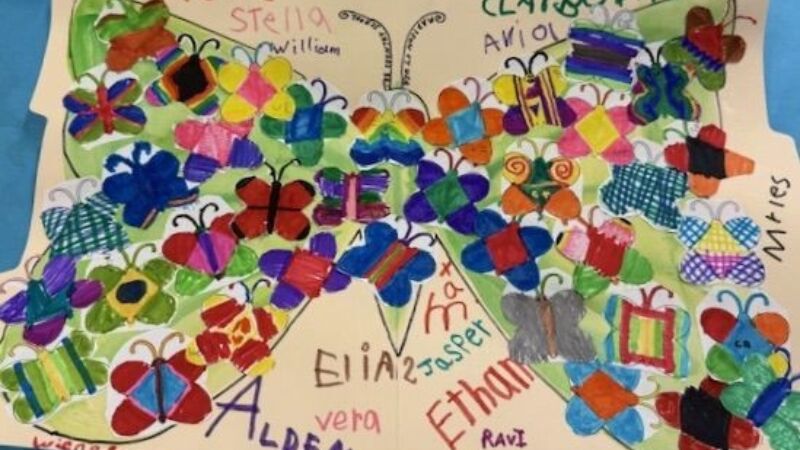
By Teresa Sullivan, The Country School communications director
Lower School STEAM Coordinator Claudia Esposito has witnessed countless "aha" moments in the classroom, but few experiences compare to watching first graders release tagged monarch butterflies into the autumn sky, knowing these tiny creatures will journey thousands of miles to Mexico. At The Country School in Madison, Connecticut, our Symbolic Monarch Migration Project has become so much more than a science lesson—it's a living bridge connecting our students to peers across North America and teaching them what it truly means to be global citizens.
A project born from passion
Since 2017, when Country School librarian and STEAM teacher Shari Lariviere first brought this initiative to life, the Monarch Migration Project has grown into a beloved school-wide tradition that she and Claudia now share. Students from preschool through eighth grade participate, but for our first graders, this becomes a comprehensive, interdisciplinary journey we call the "Mysteries of Monarchs" unit—one that touches every aspect of their learning.
The magic begins in early fall when we start raising live monarchs in our classroom and library. There's something transformative about watching a child's face as they observe a tiny egg on a milkweed leaf, track the growth of a hungry caterpillar, and witness the miracle of metamorphosis. These aren't just observations—they're intimate encounters with one of nature's most remarkable phenomena. Our campus has become an official Monarch Waystation, with milkweed gardens we planted last year, thanks to a special grant—a living laboratory where students see firsthand that conservation starts right here at home.
Where science meets global connection
Through our partnership with Monarch Watch, we tag each butterfly we raise before releasing them. These aren't ordinary butterflies—they're "super butterflies," genetically programmed to make the incredible journey to the monarch sanctuaries in Mexico. When students place those tiny tags on the butterflies' wings, they're participating in citizen science, contributing real data to an international conservation effort. Occasionally, we hear back when one of "our" butterflies is discovered in Texas, Florida, or Mexico, and the excitement in the classroom is electric.
But the true heart of global citizenship emerges through the Symbolic Migration Project. Each first grader creates a small, life-sized paper butterfly, decorated with their artwork and labeled with their first name and our Connecticut location. These butterflies are distributed to schools in the United States, creating connections between our Madison students and children they'll never meet but who share their commitment to protecting monarchs.
Art, language, and cultural exchange
The centerpiece of our cultural exchange is a large class butterfly that our students create in collaboration with art teacher Amy Peters. This isn't just an art project—it's a message of friendship decorated with Spanish words of greeting. Working with their Spanish teacher, Maria-Paz Echinique-Johnson, students craft a personalized letter in both English and Spanish, introducing themselves and sharing warm greetings with their peers in Mexico. They learn that the children who will receive their butterfly attend school within the very monarch sanctuaries where our butterflies may overwinter.
Here's where the magic of the Symbolic Migration Project truly comes alive: we don't know which school in Mexico will receive our class butterfly—and that's part of the excitement! Throughout the winter months, we monitor the Symbolic Migration website together, tracking when our class butterfly makes its journey and is hand-delivered to a school near the Monarch Butterfly Biosphere Reserve. The anticipation mirrors the butterflies' own migration, and when we finally see confirmation of delivery, students understand viscerally that their actions here in Madison matter to children thousands of miles away.
Beyond butterflies: Skills for a connected world
The academic richness of this unit is remarkable. Students explore butterfly anatomy and learn about symmetry through the monarchs' perfectly balanced wings. They understand ecosystems through the butterflies' dependence on milkweed—the only plant where monarchs lay eggs and caterpillars feed. They practice map skills by plotting coordinates from Connecticut to Mexico, following the migration route step by step.
But perhaps most importantly, students learn that they're part of an interconnected world. They discover that protecting monarchs requires cooperation across three countries. They experience the joy of reaching across language barriers to connect with peers in Mexico. They understand that their small actions—planting milkweed, raising and releasing butterflies, sharing their artwork—contribute to something much larger than themselves.
Growing global citizens
In our primary grades at The Country School, we believe that global citizenship isn't an abstract concept to be taught from textbooks—it's a lived experience. Through the Mysteries of Monarchs unit, our youngest learners become citizen scientists—collecting real-world data, connecting with children from other cultures, and driving meaningful change in the health of our future.
When a first-grader carefully releases a tagged butterfly and whispers, "Have a safe trip to Mexico," they're doing so much more than saying goodbye to an insect. Through their actions, they're influencing the well-being of our planet, contributing to climate resilience, and taking thoughtful steps toward a more sustainable world. They're discovering empathy, environmental stewardship, and the beautiful truth that we are all connected. They're embracing their role as citizens of the world.
This is STEAM education at its finest—where science, art, mathematics, and cultural understanding converge to create not just knowledgeable students, but compassionate, globally-minded young people ready to take on the world.
